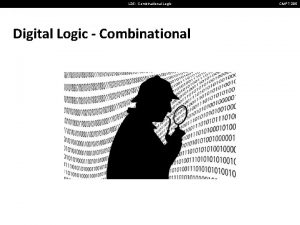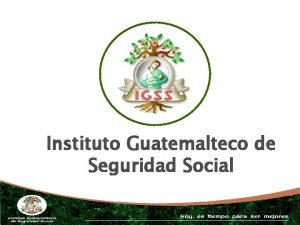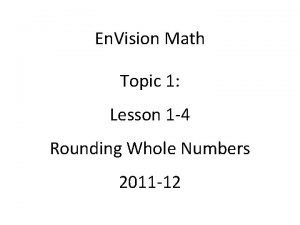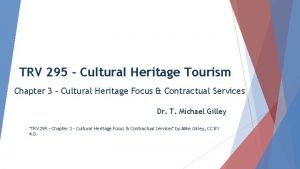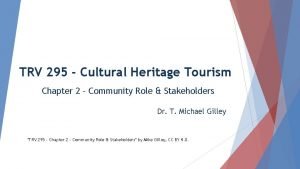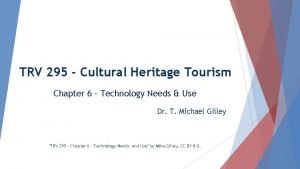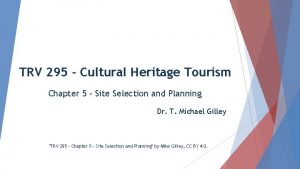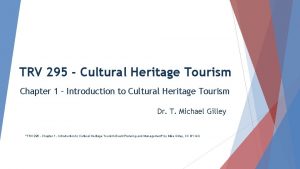TRV 295 Cultural Heritage Tourism Chapter 9 Event











- Slides: 11

TRV 295 - Cultural Heritage Tourism Chapter 9 – Event Safety & Risk Management Dr. T. Michael Gilley "TRV 295 - Chapter 9 - Event Safety & Risk Management" by Mike Gilley, CC BY 4. 0.

Risk Management ▶ De. Lisle (2014) defines risk management “as reducing liability and loss through a planned program of education, prevention, control, and evaluation” (p. 145). Even with the best planning, unforeseen accidents can happen. Risk management can reduce and eliminate some accidents. ▶ Liability refers to legal responsibility. Legal responsibility can be reduced by prevention, control, education… placing barriers such as fences between the visitors and wildlife with signs to not feed the animals. Evaluation of these efforts to prevent and reduce wildlife attacks on visitors will assist with planning for future and better risk management. ▶ Loss can include property, buildings, furnishings, equipment, supplies, contractual entertainment, finances, life, heritage culture items, authenticity, etc. Reducing loss of these objects required for cultural heritage events requires education such as training of staff to properly use sound equipment to prolong its life, having contractual agreements with performers to protect financial interests should the performers get sick and not fulfill their agreement, evaluating loss from natural forces such as winds and rain and protecting resources with accident / liability insurance.

Event Safety ▶ Event safety largely reduces liability and loss and ensures risk management. ▶ It takes evaluation of risks of the event site to prevent or reduce liability and loss through proper use and maintenance of the site, buildings, furnishings, and equipment, control of any risks that could happen with the use of appropriate supplies and planned security, fire, and medical services. ▶ You can involve the risk prevention personnel as community stakeholders on your planning committee. By knowing the details of the cultural heritage event, these professional can best assist you in evaluating the potential risks and planning to prevent and control any potential liability and loss. ▶ These professionals need to also be at the event to put a liability and risk management plan into action with an added layer of control and security to prevent loss if and when an unforeseen accident happens.

Education ▶ To prevent, control, and evaluate liability and loss, you need to educate your staff and volunteers with the layout of the site and facilities, basic communication means, security measures, emergency procedures, and first aid training. ▶ You need to also educate your visitors with well marked maps of the site and facilities with communication, security, emergency, and first aid stations clearly indicated not only on the map but with easily recognizable signage.

Prevention & Control ▶ To prevent and control risks and loss, first eliminate any risks identified through the initial evaluation. ▶ If the risks or loss cannot be eliminated, then reduce them as much as possible. ▶ If the risks or loss cannot be reduced, then accept the risks totally or partially. ▶ If accepting the risks, the event organizer can decide to share the risk burden with the event participants or insurers. ▶ Control of risks and loss can be accomplished for future events through planning with loss prevention goals, identifying training needs, and providing training opportunities. ▶ Evaluation of successes and losses at each occurrence of an event can assist with the evaluation of the event’s risk management plan.

Liability and the Law ▶ According to De. Lisle (2014), event organizers assume the following responsibilities for their visitors: ▶ adequate supervision, ▶ appropriate and well-conducted activities, and ▶ safe and appropriate environmental conditions” (p. 153).

Case Study 1 – Blue Ridge Folklife Festival ▶ The Blue Ridge Folklife Festival provides bright orange plastic event fencing to enclose the event area providing limited and supervised ticket gates to control entrance and exit at the festival. Festival bracelets are worn to identify festival attendees. ▶ The festival area is divided by a highway which is supervised at two areas by state police who stop the traffic to allow pedestrians to cross the road. ▶ Paid staff and security supervise the gates and festival grounds and buildings. ▶ Emergency fire and rescue vehicles with trained personnel are stationed at different areas on the festival grounds. ▶ Public transportation is provided for festival visitors. ▶ Festival staff, vendors, demonstrators, and performers are clearly identified.

Case Study 2 – Home Craft Days ▶ Although the festival grounds are not enclosed, the festival events are restricted to one building and three parking areas on the college campus. The event is not ticketed and there are only t-shirts and tags to identify the festival staff and volunteers and uniforms to identify security, fire, and emergency personnel. ▶ Paid staff and security supervise the festival grounds and buildings. ▶ Emergency fire and rescue vehicles with trained personnel are stationed centrally at the festival. ▶ Public transportation is provided for festival visitors. ▶ Festival staff, vendors, demonstrators, and performers are clearly identified.

Case Study 3 - Merle. Fest ▶ Merlefest occupies several buildings and tents on the grounds of Wilkes Community College. Supervised ticket gates control the entrance and exit at the festival. Festival bracelets are worn to identify festival attendees. ▶ Visitors walk to the festival gates from parking areas off campus or ride buses operated by regional Boy Scout troops for a fee to the campus and festival gates. Bags and chairs are checked at the festival gates. Campus security are visible at the gates as well as other areas around campus. ▶ Paid staff and security supervise the gates and festival grounds and buildings. ▶ Emergency fire and rescue vehicles with trained personnel are stationed at different areas on the festival grounds. ▶ Festival staff, vendors, demonstrators, and performers are clearly identified.

Assignment for Chapter 9 ▶ Does your case study for cultural heritage tourism have a risk management plan? ▶ What does it include for education, prevention, control, and evaluation? ▶ What measures does your case study take to ensure event safety?

Resources ▶ de. Lisle, L. J. (2014). Creating special events. Urbana, IL: Sagamore Publishing. ▶ Gilley, T. M. (2016). Institutions of higher education and cultural heritage tourism: A case study of the Crooked Road, Virginia’s heritage music trail. Ann Arbor: Pro. Quest.





